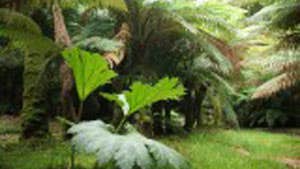Derreen Gardens covers more than 60 acres of garden and has over 12km of paths which wind through mature and varied woodland to reveal wonderful views over Kilmakilloge Harbour, the Caha Mountains and the distant McGillicuddy Reeks. The garden is full of rare and exotic plants, many of which were brought back from the Himalayas and elsewhere. Derreen is particularly known for its collection of rhododendrons. The labyrinth of narrow mossy paths weave their way through groves of bamboo, towering eucalyptus, tree ferns and conifers, all thriving in the mild, damp climate.
The garden is also a haven for wildlife and a habitat for Sika deer, Irish hares and red squirrel. Seals can often be seen from the shore and there have been sightings of otters and Kerry’s rarest mammal, the pine marten. By the shore there is an abundance of bird life, including cormorants, oyster catchers, gulls, great northern divers, guillemots and sea eagles.
There are a number of walks around the garden taking 30 minutes to an hour, although it is easy to get drawn into exploring and many visitors will spend a few hours before finishing off their visit with a picnic, cream tea (available at the cottage close to the car park) or a trip to the nearby pub at Kilmakilloge.
For Children
The “Derreeny Houses” are located in Derreen Garden along the Glade Walk and the adjacent section of the Broad Walk. To date 20 such houses have been found. All the houses are vacant, but look like they have recently been lived in. There have been reports from children walking in the garden of movements in the Rhododendrons as they walk along the paths in the garden.. “Derreenies” are about 2 inches (5cm) tall, but, are rarely seen. The last sighting of a “Derreeny” was in 1855.
The land around Derreen came into the ownership of the Fitzmaurice family in 1657 through Sir William Petty, physician to Oliver Cromwell. When the 5th Marquis of Lansdowne succeeded in 1866 he was drawn to the remoteness of the place and decided to make Derreen his summer home. Today the house still belongs to his descendants.
In 1870 he embarked on an ambitious plan to transforms the bare rock and scrub oak around the house into the luxurious woodland garden of today. He planted 400 acres of shrubs and trees, many of them brought back from his sojourns as Viceroy of India and Governor General of Canada.
